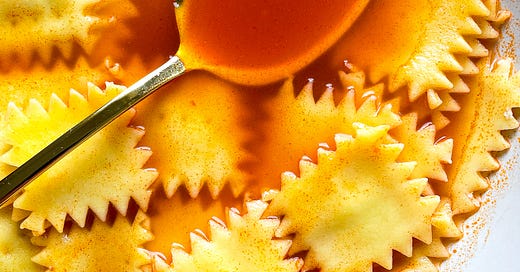As a proud pasta nerd, I take particular pleasure in learning about each shape’s name. Some refer to a legend or myth about how a pasta came to be; others evoke its physical form; still others are far more amusing than they are palatable. Vermicelli—“little worms”—are perhaps the most egregious of the bunch, with lumache (“snails”), linguine (“little tongues”), and strozzapreti (“priest stranglers”) following close behind. Today’s Pasta of the Month falls into this category, too: sfoglia lorda, or spoja lorda, which means “dirty pasta” or “dirty dough.”
Although not the most flattering moniker, sfoglia lorda makes up for it in fun and flavor. It’s a pasta from Emilia-Romagna (particularly the medieval towns of Faenza and Brisighella), the home of shapes like tortellini and cappelletti, that’s managed to stay under-the-radar among such famous friends. As with so many pastas, especially those from this region, sfoglia lorda is the resourceful result of leftovers. At its inception, the last remnants of filling—specifically, the filling used to make cappelletti magri (cheese-filled cappelletti)—were thinned out with a splash of milk and spread, like mayo on bread, across half of a large, round sheet of dough. The other half of the pasta sheet was layered on top, and the “dirty-dough” sandwich was cut into small squares with a fluted pasta cutter. Traditionally, these mini ravioli are served in meat broth in winter and tomato sauce in summer.
Of course, I love making intricate filled pastas, particularly around the holiday season. But I also love a good shortcut, and sfoglia lorda is just that: all the deliciousness of filled pasta with a fraction of the effort. And, as with most successful experiments, sfoglia lorda is now made on purpose: Today, the filling typically consists of fresh local cheeses like ricotta, squacquerone, raviggiolo, campagnolo, stracchino, and robiola, as well as a lot of Parmigiano-Reggiano. The King of Cheeses is a must—both for flavor and texture since it acts as a thickener—but the others are adaptable, which is great for those of us without access to a wide variety of Italian cheeses. A common substitute for the rarer varieties is a soft, mild goat cheese—the tang mimics the flavor of squacquerone—or, if you’re not a goat cheese person, boursin, cream cheese, and maybe even Valbreso work, too.
It might be October, but I’ll admit I last made this in August in rare moment of productivity (or was it panic?) while looking at my fall calendar. At the time, I took full advantage of the late-summer produce and made the tomato broth from my cookbook, which felt like the perfect confluence of this pasta’s traditional condiments. The tomato broth has a bit of a Spaghetti-Os vibe, and adding these pasta postage stamps brought an extra layer of childhood nostalgia. Now that the air is cooler, I’d recommend any simple meat or vegetable broth (see serving instructions below), or an easy tomato sauce, some pesto you might have tucked in the freezer, or even just good olive oil and a sprinkle of cheese. Any soup—chicken soup, tomato soup, roasted squash soup—is also a great home for these mini cheese sandwiches.
One more note: If there’s one piece of special equipment worth using here, it’s a fluted pasta wheel (I like this one). These are designed to seal and cut the pasta at the same time, which helps prevent the sfoglia lorda from leaking. Still, it’s totally fine if a bit of filling pops out as you cut—the egg acts as a binder and helps hold everything together during the cooking process.
Sfoglia Lorda
Serves 4





